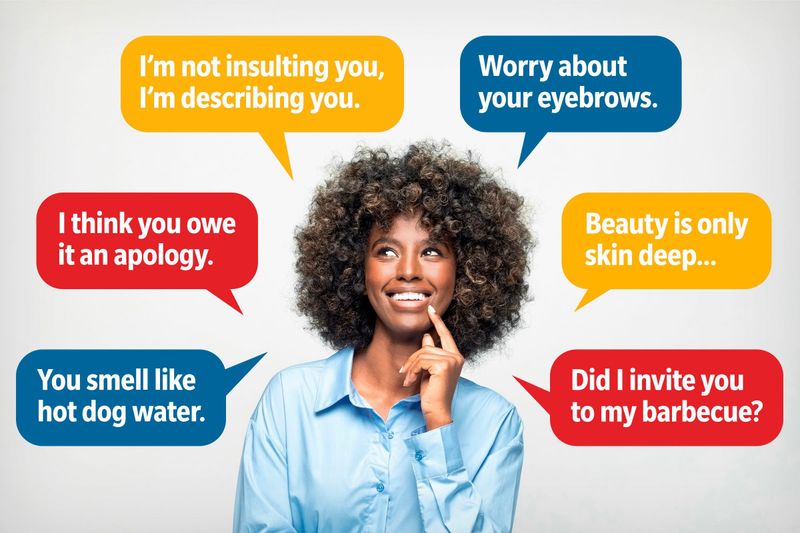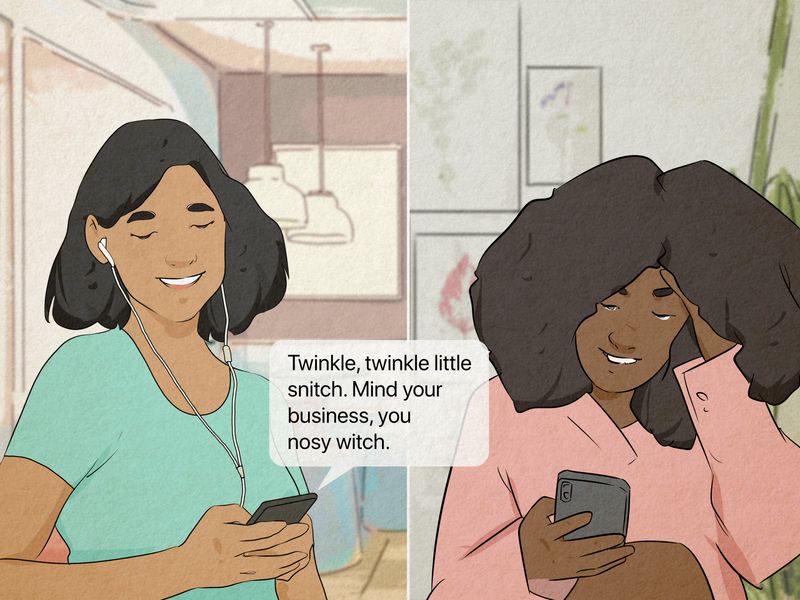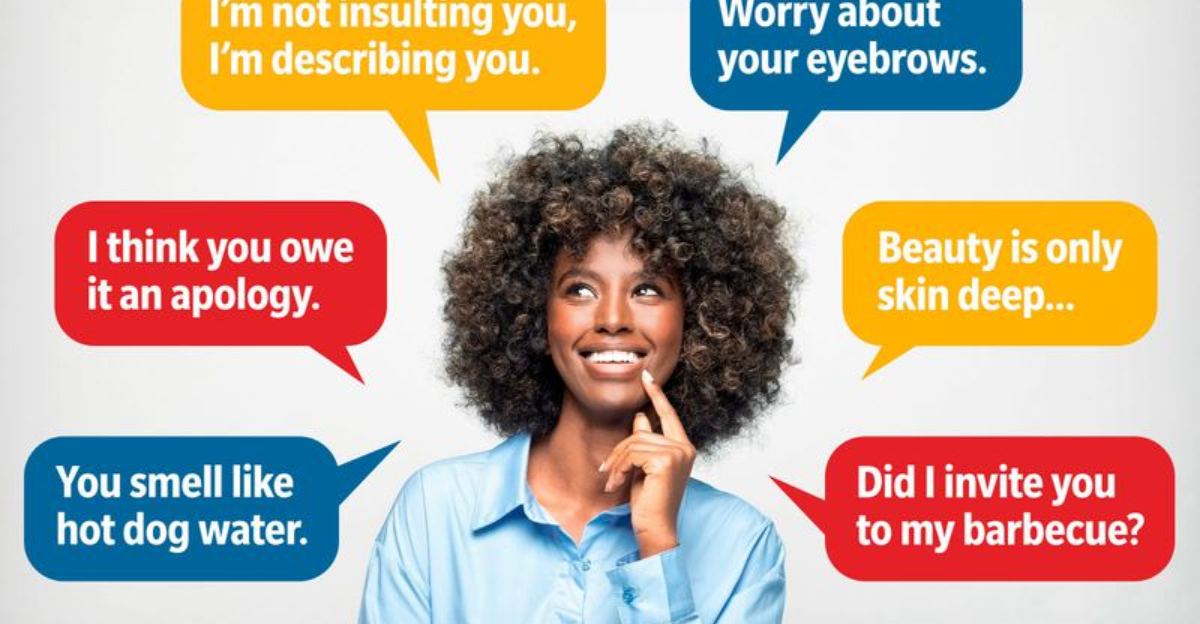15 Comebacks That Shut Down Passive Aggressive Comments Cold
Navigating the murky waters of passive-aggressive comments can be challenging, but armed with the right comebacks, you can maintain your poise and turn the tables with flair.
Here, we present 15 sharp yet courteous responses that not only handle awkward situations with grace but also leave the other party reevaluating their words.
Each comeback is designed to be delivered with confidence, keeping you in control while subtly sending the message that you’re not one to be trifled with. Get ready to master the art of verbal self-defense with style.
1. Wow, that was oddly specific.

In the realm of verbal exchanges, specificity can be a double-edged sword. When someone delivers a comment wrapped in precision, it often carries an undercurrent. This comeback turns their weapon against them, highlighting the peculiar nature of their observation.
It’s like saying, “I see your game, and I’m amused.” Delivered with a casual air, it instantly shifts the focus back onto the speaker, urging them to reconsider their words without any need for confrontation.
This phrase works wonders in diffusing tension. Instead of letting the comment linger, it pivots the conversation, allowing for a reset. The speaker might chuckle, realizing the unintended humor. It’s a light but effective reminder that their attempt at subtlety didn’t go unnoticed.
Using this approach, you maintain the upper hand, showcasing wit without resorting to hostility. It’s a clever, calm retort, perfect for any setting.
2. Thanks for your unsolicited honesty.

Honesty, they say, is the best policy—but when it’s unsolicited, it can tread into tricky territory. This comeback is your subtle way of acknowledging their honesty while implying it might not have been necessary. It’s a graceful nod to their attempt at transparency, wrapped in a layer of ironic appreciation.
The beauty of this phrase lies in its ability to disarm. It acknowledges the comment without dismissing it, transforming what could be a prickly moment into one of mutual understanding. Delivered with a smile, it suggests maturity and self-assurance.
In social settings, this phrase can redirect the conversation, signaling that you’re unfazed by the remark. It’s a gentle reminder that while exchange is welcome, it’s best served with consideration. This comeback not only preserves dignity but also subtly challenges the speaker to rethink their approach.
3. You say that like it’s a compliment.

Sometimes, comments are wrapped in layers of backhandedness, masquerading as compliments. This comeback cuts through the facade, laying bare the true nature of the words. By framing it as a compliment, you flip the script, inviting the speaker to clarify their intent without confrontation.
This phrase is perfect for situations where ambiguity reigns. It empowers you to maintain control while gently prompting the speaker to rethink their delivery. Delivered with a playful tone, it indicates you’re not easily swayed by superficial flattery.
The underlying message? You see through facades and expect respect. It’s an invitation for honesty and a reminder that authenticity trumps pretense. This comeback is versatile, suited for school corridors or workplace interactions, wherever backhanded compliments might rear their heads.
4. Noted. Moving on.

Brevity is an art, and this comeback is its masterpiece. When faced with passive-aggressive remarks, this response effectively acknowledges the comment while simultaneously closing the door on further discussion. It’s a power move—a statement that you’ve heard, processed, and are ready to move forward.
This phrase is particularly useful in professional settings where maintaining decorum is key. It allows you to acknowledge input without being derailed. With just two words, you assert control over the conversation, steering it back to more constructive territory.
Using this comeback, you silently communicate that you’re focused on progress, not pettiness. It’s a nod to productivity and professionalism, encouraging others to follow suit. In any environment, it exemplifies grace under pressure, making it a staple for those who value efficiency and respect.
5. Interesting tone—want to try that again?

Tone can be everything in communication. When it veers into the passive-aggressive, this comeback offers the speaker a chance to recalibrate. It’s an invitation to reflect and rephrase, all while maintaining a cordial atmosphere.
By highlighting the “interesting” nature of the tone, you subtly nudge the speaker towards more direct communication. It’s a light-hearted way to address the issue without escalating tensions, promoting clarity and openness.
This phrase is most effective in social settings where maintaining harmony is paramount. It turns a potentially awkward moment into an opportunity for constructive dialogue. With its blend of curiosity and assertiveness, it encourages honesty, paving the way for more genuine interactions.
6. I’m not sure that landed how you hoped.

Communication can sometimes miss the mark, and this comeback gently points that out. It allows you to acknowledge the intent while subtly suggesting that the delivery fell short. With this phrase, you open the door for clarification, encouraging a more thoughtful exchange.
It’s especially handy in situations where miscommunication could lead to misunderstandings. By inviting the speaker to revisit their words, you foster an environment of mutual respect and understanding. It’s a nudge towards clearer expression without blame.
Incorporating this comeback into your repertoire signals maturity and emotional intelligence. It’s perfect for settings where connection and comprehension are valued, ensuring that conversations remain constructive and respectful.
7. Is this you being helpful or just clever?

We’ve all encountered comments that straddle the line between helpfulness and clever critique. This comeback shines a light on that ambiguity, prompting the speaker to assess their intent. It’s a playful challenge, wrapped in a friendly inquiry.
In using this phrase, you engage the speaker in self-reflection, urging them to consider the impact of their words. It’s a way of balancing the scales, ensuring that the exchange remains respectful and reciprocal.
Ideal for casual settings, this comeback transforms potential friction into an invitation for sincerity. It’s a gentle reminder that while cleverness can be charming, clarity and kindness often hold more weight in meaningful interactions.
8. You’re welcome to say what you mean.

Ambiguity can muddle communication, and this comeback offers a clear path forward. By inviting the speaker to express themselves directly, you encourage transparency and honesty, reducing potential for misinterpretation.
This phrase is particularly effective in conversations where clarity is key. It signals your openness to straightforward dialogue, fostering an atmosphere where genuine exchange can flourish. Delivered with warmth, it reassures the speaker that honesty is appreciated.
Incorporating this comeback in discussions promotes mutual respect, paving the way for more meaningful interactions. It’s a testament to your commitment to understanding, urging others to embrace the same level of openness and integrity.
9. I don’t do hidden meanings. Try me straight.

In the dance of conversation, hidden meanings can disrupt the rhythm. This comeback cuts through the noise, inviting directness and authenticity. It’s a clear declaration that you value candor over ambiguity.
By asserting that hidden meanings aren’t your style, you encourage others to engage with honesty. This phrase serves as both a boundary and an invitation, marking a space where genuine communication thrives.
Ideal for professional environments, this comeback promotes clarity and respect. It’s a reminder that straightforward dialogue is not only appreciated but expected, ensuring that exchanges remain productive and sincere.
10. You could’ve just said that without the side-eye.

Non-verbal cues often speak volumes, and this comeback highlights their role in communication. By acknowledging the side-eye, you bring attention to the unspoken elements of the exchange, encouraging a more open dialogue.
This phrase is perfect for moments where body language contradicts spoken words. It’s a gentle nudge towards sincerity, wrapped in humor and understanding. Delivered with a smile, it diffuses tension, making room for honesty.
In social settings, this comeback fosters an environment of trust and transparency. It’s an invitation to align words with actions, ensuring that interactions remain genuine and respectful. With this phrase, you set the stage for clearer, more meaningful connections.
11. Cool story. Anyway…

Every conversation has its tangents, but when they veer into the realm of passive-aggressiveness, this comeback redirects with finesse. It acknowledges the story while steering the dialogue back to a more constructive path.
By labeling the tale as “cool,” you maintain a light, engaging tone, softening the transition back to the main topic. It’s a subtle way of signaling that while the narrative was noted, it’s time to move on.
Ideal for casual settings, this phrase demonstrates your ability to control the flow of conversation. It’s a nod to your conversational agility, ensuring that discussions remain focused and meaningful, without unnecessary detours.
12. If that’s a joke, I’ll pass.

Humor can be subjective, and not all jokes land as intended. This comeback acknowledges the attempt at humor while signaling that it missed the mark. It’s a playful way of drawing attention to the misalignment without dampening the mood.
By framing it as a joke you’ll pass on, you maintain a light-hearted atmosphere, inviting the speaker to reconsider their delivery. It’s an opportunity for the conversation to pivot towards more inclusive humor.
In group settings, this phrase helps keep the interaction lively and respectful. It’s a reminder that while humor is welcome, it’s most effective when it resonates with everyone involved. This comeback is a testament to your understanding of the delicate balance in social exchanges.
13. I don’t need feedback you didn’t mean to give.

Feedback is invaluable, but only when it’s intentional and constructive. This comeback respects the speaker’s input while subtly questioning its relevance. It’s a polite way of suggesting that perhaps the feedback wasn’t necessary.
With this phrase, you establish the importance of purposeful communication. It signals your receptiveness to meaningful input, encouraging others to contribute thoughtfully. Delivered with grace, it turns potential awkwardness into a learning moment.
In professional settings, this phrase sets a standard for feedback quality. It’s a reminder that while all voices are heard, those with clear, constructive intent will resonate most. This comeback underscores your commitment to productive dialogue, fostering an atmosphere of respect and growth.
14. That felt like a dig—should we pause here?

Navigating conversations with tact involves recognizing when words cut deeper than intended. This comeback acknowledges the sting while offering a moment for reflection and recalibration. It’s a gentle prompt for both parties to pause and reassess.
By labeling the comment as a “dig,” you bring to light the underlying tone, encouraging the speaker to reconsider their words. It fosters an environment where intentions can be clarified, steering the dialogue back to a constructive path.
Ideal for personal interactions, this phrase promotes empathy and understanding. It’s a reminder that while words have power, they should be used to build bridges, not barriers. This comeback champions thoughtful communication, ensuring that exchanges remain respectful and meaningful.
15. I like honesty better when it’s actual honesty.

Honesty is a valued trait, but it must be genuine to hold weight. This comeback champions authenticity, challenging the speaker to align their words with true sincerity. It’s a call for the real deal, not a veiled attempt at truth.
By expressing a preference for “actual honesty,” you set a standard for meaningful communication. It’s an invitation for the speaker to discard facades, fostering an environment where genuine exchange prevails.
Perfect for settings where clarity is crucial, this phrase underscores the value of transparency. It’s a nod to the importance of integrity in dialogue, ensuring that conversations are based on trust and mutual respect. This comeback is a beacon of honest communication, guiding interactions toward authenticity.






